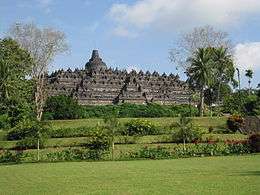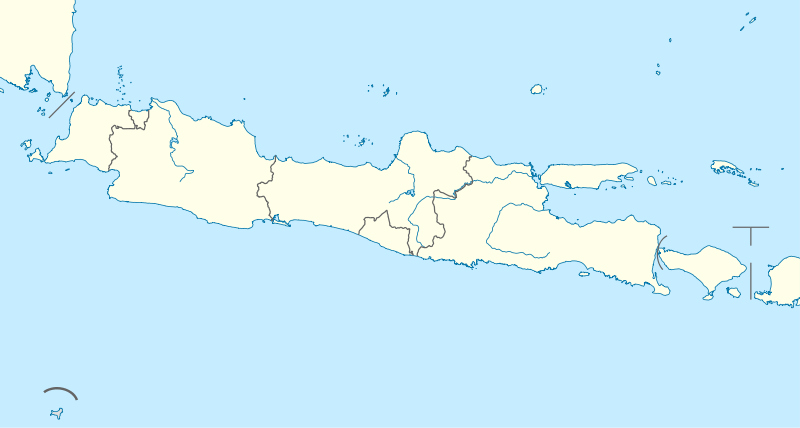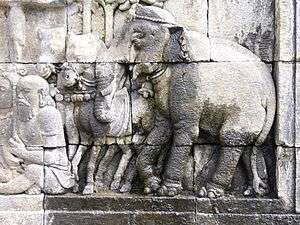Borobudur Temple Compounds
| Borobudur Temple Compounds | |
|---|---|
|
Native name Indonesian: Kompleks Candi Borobudur | |
 Borobudur Northwest View | |
| Location | Magelang, Central Java |
| Coordinates | 7°36′29″S 110°12′14″E / 7.608°S 110.204°ECoordinates: 7°36′29″S 110°12′14″E / 7.608°S 110.204°E |
| Type | Cultural |
| Criteria | i, ii, vi |
| Designated | 1991 (15th session) |
| Reference no. | 592 |
| State Party |
|
| Region | Southeast Asia |
| Includes |
Borobudur Mendut Pawon |
 Location within Java  Borobudur Temple Compounds (Indonesia) | |
Borobudur Temple Compounds is a term used by the World Heritage designation of the area of three Buddhist temples in Central Java, Indonesia. It comprises Borobudur, Mendut, and Pawon. These three temples are located in a straight line, and have been considered as being built during the Shailendra dynasty circa 8th–9th centuries.
Approximately 40 kilometres (25 mi) northwest of Yogyakarta, Borobudur is located in an elevated area between two twin volcanoes, Sundoro-Sumbing and Merbabu-Merapi, and two rivers, the Progo and the Elo. According to local myth, the area known as Kedu Plain is a Javanese 'sacred' place and has been dubbed 'the garden of Java' due to its high agricultural fertility.[1]
During the restoration in the early 20th century, it was discovered that three Buddhist temples in the region, Borobudur, Pawon and Mendut, are positioned along a straight line.[2] It might be accidental, but the temples' alignment is in conjunction with a native folk tale that a long time ago, there was a brick-paved road from Borobudur to Mendut with walls on both sides. The three temples (Borobudur–Pawon–Mendut) have similar architecture and ornamentation derived from the same time period, which suggests that ritual relationship between the three temples, in order to have formed a sacred unity, must have existed, although exact ritual process is yet unknown.[3]
Museums
There are two museums located within Borobudur Temple Compounds, Karmawibhangga Museum and Samudra Raksa Museum.
|
Other archaeological sites


Besides these three temples, there are other Buddhist and Hindu temples scattered in the area. The earliest is Gunung Wukir or Canggal Hindu temple dated 732 CE, according to Canggal inscription discovered in the temple complex, the Shivaite King Sanjaya commissioned a Shivalinga sanctuary to be built on the Wukir hill, only 10 km (6.2 mi) east of Borobudur.[4] Ngawen temple located east of Mendut temple. The ruin of Banon temple, a Hindu temple located several hundred meters north of Pawon temple. The ruin of Banon temple is unreconstructable because many stones were missing, however several stone statues of Hindu gods were discovered in good condition in this area. Today the Banon statues of Vishnu, Brahma, Shiva and Ganesha were displayed in National Museum of Indonesia, Jakarta.
See also
Notes
- ↑ Soekmono (1976), page 1.
- ↑ N. J. Krom (1927). Borobudur, Archaeological Description. The Hague: Nijhoff. Archived from the original on 17 August 2008. Retrieved 17 August 2008.
- ↑ J. L. Moens (1951). "Barabudur, Mendut en Pawon en hun onderlinge samenhang (Barabudur, Mendut and Pawon and their mutual relationship)" (PDF). Tijdschrift voor de Indische Taai-, Land- en Volkenkunde. Het Bataviaasch Genootschap van Kunsten en Wetenschappen: 326–386. Archived from the original (PDF) on 2007-08-10.
trans. by Mark Long
- ↑ W. J. van der Meulen (1977). "In Search of "Ho-Ling"". Indonesia. 23: 87–112. doi:10.2307/3350886.
External links





